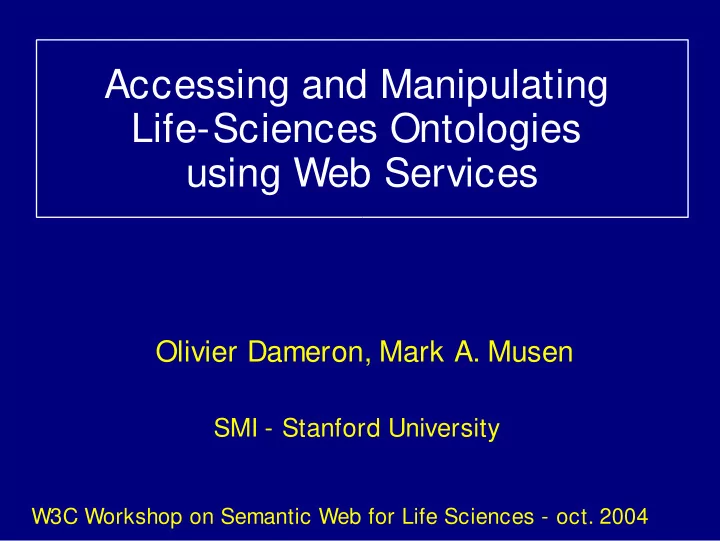

Accessing and Manipulating Life-Sciences Ontologies using Web Services Olivier Dameron, Mark A. Musen SMI - Stanford University W3C Workshop on Semantic Web for Life Sciences - oct. 2004
Context: Semantic needs for Life Sciences Huge ∃ corpus of distributed data and kn. automate access automate retrieval automate processing Syntactic and semantic heterogeneity explicit and formalized representation of kn. Applications need to cooperate automate as much as possible
Context: Overlap with the SW approach Limitations are common with other domains sharing D, sharing K, enhance interop. Web Technologies = promising approach some are already mainstream ∃ efforts for representing and formalizing K GO, OMIM, MGED, Galen, FMA However: under exploited not inter-connected
Hypothesis Life Sciences = interesting test case for a Semantic Web killer app Some of the outcome could be generalized to other domains
Objectives Identify ontology manipulation functions application and domain-independant Implement them as Web Services: OWS scenario of need for OWS in LS context can be implemented with current technologies OWS are also necessary to SW framework processing semantic descr. of regular WS automatic retrieval, composition
OWS Categories Queries Views Translations Mapping Versioning Merging Reasoning
OWS Categories Ontology Ontology VIEW OWS View def. Ontology Ontology TRANSLATION Language Ontology Variables QUERY OWS mapping Query string
OWS Implementation scenario Retrieve the clinical trials relevant to a patient with lung tumor stage the patient's tumor query to NCI clinical trials online DB
OWS Implementation scenario
TNM classification TNM: T0 – T4: primary tumor N0 – N3: metastasis in lymph nodes M0 – M1: distant metastasis Stage 0 - IV: derived from the TxNyMz score Requires: Representation TxNyMz criteria + stages Taxonomy of tumors + pathologies Taxonomy + partonomy of anatomy
TNM classification TNM: T0 – T4: primary tumor N0 – N3: metastasis in lymph nodes M0 – M1: distant metastasis Stage 0 - IV: derived from the TxNyMz score Requires: Representation TxNyMz criteria + stages Taxonomy of tumors + pathologies NCI Taxonomy + partonomy of anatomy FMA
FMA NCI Create View Create View Lung Lung Tumor View View Translate TNM Lung Merge View (OWL) Reasoning Extended TNM
OWS for the Semantic Web Automating usage of WS discovery execution composition Requires explicit description syntactically valid communication: SOAP, WSDL semantic aspect: OWL-S How do apps automatically access and process semantic descriptions ? OWS
OWS for assessing WS relevance OWL-S 1 Description WS Client
OWS for assessing WS relevance OWS OWS OWS Reasoning Mapping ... 2 OWL-S 1 Description WS Client
OWS for assessing WS relevance OWS OWS OWS Reasoning Mapping ... 2 OWL-S 1 Description WS Client WS 3 Server
OWS for semantic interoperability Compute WS Input params WS Relevance OWS OWS (prev. slide) 3 2 OWL-S 1 Description WS Client
OWS for semantic interoperability Compute WS Input params WS Relevance OWS OWS (prev. slide) 3 2 OWL-S 1 Description WS Client WS 4 Server
OWS for semantic interoperability Compute WS Compute WS Output params Input params WS Relevance OWS OWS OWS (prev. slide) 5 3 2 OWL-S 1 Description WS Client WS 4 Server
Conclusion Life Sciences: priviledged domain ∃ ontologies ∃ application needs commercial opportunities Use of OWS for linking isolated resources OWS also play a role in the SW development
Recommend
More recommend